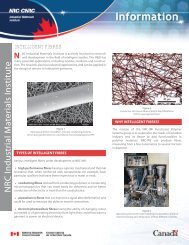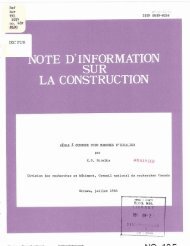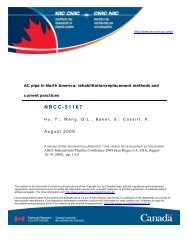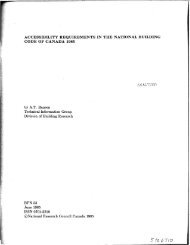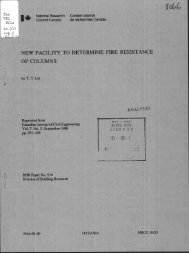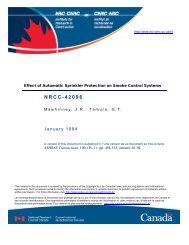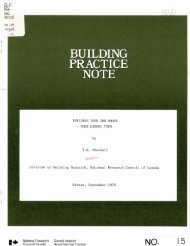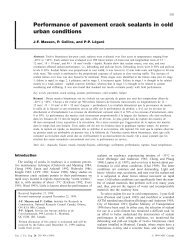Traffic-induced building vibrations in Montréal - National Research ...
Traffic-induced building vibrations in Montréal - National Research ...
Traffic-induced building vibrations in Montréal - National Research ...
You also want an ePaper? Increase the reach of your titles
YUMPU automatically turns print PDFs into web optimized ePapers that Google loves.
Hunaidi and Tremblay 747Fig. 6. Layout of site 9 show<strong>in</strong>g location of wood plank attached to road surface. (All dimensions are <strong>in</strong> meters.)value was for the second-storey measurement po<strong>in</strong>t; ratioswere higher at other po<strong>in</strong>ts <strong>in</strong> the <strong>build<strong>in</strong>g</strong>). For PSR values of4 and 0 represent<strong>in</strong>g road conditions before and after resurfac<strong>in</strong>g,Rudder’s (1978) approximate relationship would give areduction factor of 6.9. This is <strong>in</strong> good agreement withthe m<strong>in</strong>imum reduction factor of 6.4 found above. Therefore,it may be a reasonable suggestion for the time be<strong>in</strong>g to applyRudder’s relationship for site conditions <strong>in</strong> Montréal. Needlessto say, however, more tests at other sites hav<strong>in</strong>g PSR valuesdifferent from that of the site selected <strong>in</strong> this study would berequired to further validate the applicability of this relationship.Vibration levelsVibration levels listed <strong>in</strong> Table 4 for the bus and the truck at 25and 50 km/h before road resurfac<strong>in</strong>g were substantially higherthan the ISO 2631/2 guide value of 0.001g (rms). The correspond<strong>in</strong>gvibration levels after the road was resurfaced weresignificantly reduced, as can be seen from the values listed <strong>in</strong>Table 5. For the truck, vibration levels became lower than theguide value at all po<strong>in</strong>ts <strong>in</strong>side the <strong>build<strong>in</strong>g</strong>. For the bus at50 km/h, however, vibration levels <strong>in</strong> the second storey rema<strong>in</strong>edhigher than the guide value by about 50% (vibrationlevels were six times the ambient acceleration levels of0.24 × 10 –3 g (rms))! Tenants might cont<strong>in</strong>ue to compla<strong>in</strong> <strong>in</strong>view of past experience by the City of Montréal that for somesites vibration compla<strong>in</strong>ts persisted even after the road wasresurfaced.It is <strong>in</strong>terest<strong>in</strong>g to note that vibration levels <strong><strong>in</strong>duced</strong> by theempty bus at 50 km/h (both before and after the road wasresurfaced) were similar to and <strong>in</strong> some cases higher than thecorrespond<strong>in</strong>g vibration levels <strong><strong>in</strong>duced</strong> by the loaded bus. Thesame trend was observed earlier by Al-Hunaidi and Ra<strong>in</strong>er(1991) us<strong>in</strong>g an empty and a loaded water truck and by Watts(1990) us<strong>in</strong>g empty and loaded trucks. Also worth not<strong>in</strong>g <strong>in</strong>Table 4 is that vibration levels <strong><strong>in</strong>duced</strong> by the bus and the truckat a speed of 25 km/h before the road was resurfaced weresimilar. At 50 km/h, however, <strong>vibrations</strong> <strong><strong>in</strong>duced</strong> by the buswere more than two times those <strong><strong>in</strong>duced</strong> by the truck. Obviously,the relationship between vehicle speed and vibrationlevels depends on the vehicle characteristics.Effect of seasonal variations <strong>in</strong> soilconditionsSoil conditions at compla<strong>in</strong>t sites, particularly the frost layer <strong>in</strong>w<strong>in</strong>ter and the level of ground water table, are believed to<strong>in</strong>fluence the level of traffic-<strong><strong>in</strong>duced</strong> <strong>vibrations</strong>. However, theextent of this <strong>in</strong>fluence is not clear. In a study of <strong>vibrations</strong><strong><strong>in</strong>duced</strong> by buses <strong>in</strong> W<strong>in</strong>nipeg, Sutherland (1950) reported that<strong>vibrations</strong> measured <strong>in</strong> w<strong>in</strong>ter while the top soil was frozenwere significantly less than those measured <strong>in</strong> summer.On theother hand, subway-<strong><strong>in</strong>duced</strong> <strong>vibrations</strong> <strong>in</strong> <strong>build<strong>in</strong>g</strong>s that weremeasured more recently <strong>in</strong> Toronto were found to be slightlyhigher <strong>in</strong> w<strong>in</strong>ter (while the top soil was frozen) than <strong>in</strong> summer.1 Tests were performed <strong>in</strong> this study to determ<strong>in</strong>e the trendfor conditions <strong>in</strong> Montréal.Officials of many cities <strong>in</strong> Canada <strong>in</strong>dicate that vibrationcompla<strong>in</strong>ts are more frequent dur<strong>in</strong>g the thaw period <strong>in</strong> spr<strong>in</strong>gthan <strong>in</strong> other seasons. The extent to which the higher level ofground water table <strong>in</strong> the spr<strong>in</strong>g thaw period adversely affectvibration levels was not known. Tests were thus performed <strong>in</strong>this study to shed some light on this issue.Description of testsTests were performed at site 9 after the road was resurfaced.Identical measurements of <strong>vibrations</strong> <strong><strong>in</strong>duced</strong> by a test buswere made dur<strong>in</strong>g the fall, w<strong>in</strong>ter, and spr<strong>in</strong>g. Visual <strong>in</strong>spectionof the road surface at time of measurements <strong>in</strong> the differentseasons <strong>in</strong>dicated that the road condition was almost identical.Tests were performed us<strong>in</strong>g a bus while empty and loaded; notrucks were used. The test bus was driven at speeds of 25 and50 km/h with and without a wood plank attached to the roadsurface. The wood plank was 3.7 cm high, 13.8 cm wide, and90 cm long. Only the far side of the bus passed over the woodplank located as shown <strong>in</strong> Fig. 6. Only the results obta<strong>in</strong>edwith the wood plank attached to the road are presented here;vibration levels for tests performed with no wood plank werelow and consequently the ratios between vibration levels <strong>in</strong> the1Bracken, M. 1994. Aercoustics Eng<strong>in</strong>eer<strong>in</strong>g Limited, Rexdale,Ont., Private communication.© 1997 NRC Canada




